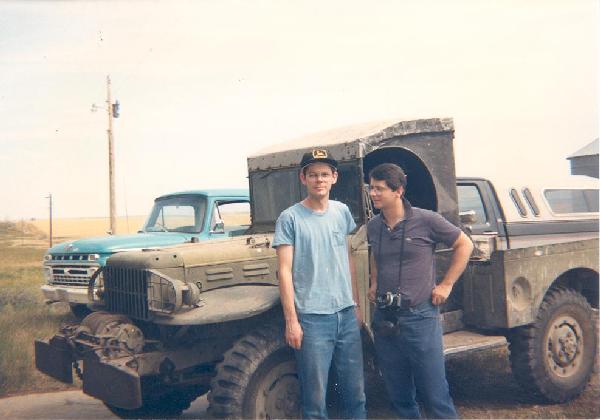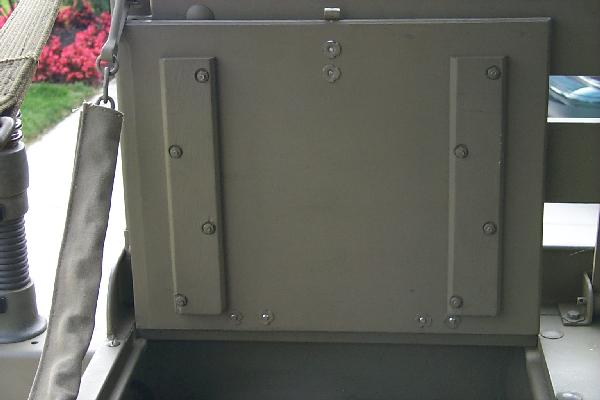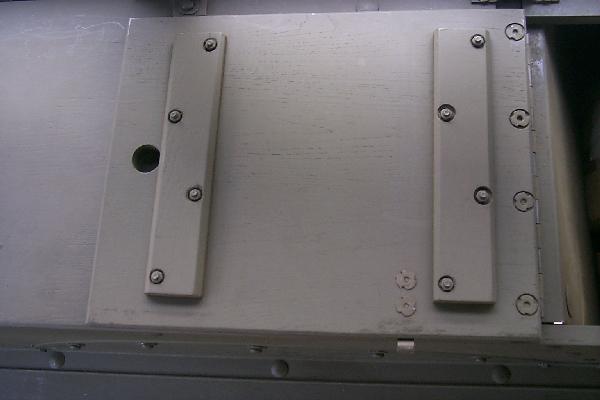
Figure 1. The WC-52 before restoration.
I became aware that little information is available for the cargo box description of late model WC-51/52 vehicles during a frame up restoration. I was fortunate for this restoration since the cargo box was in good condition. My vehicle, a WC-52, has been in my family on the family farm in Eastern Montana since the end of WW II. My uncle had acquired it as surplus equipment in an auction at the Tacoma ordinance plant. He had driven it from there to the farm during the late fall in 1945 on a three day drive. I am sure it was a `warm' drive over the Rockies in an open cab.
The weapons carrier began life on the farm as a grain truck. The upper horizontal wood surfaces were covered with tin sheeting to minimize grain loss through any cracks and the tail gate was removed, stored and replaced by another one with a sliding gate to allow grain to gravity drain from the cargo box. The hauling capacity was increased by extending the height of the cargo box with additional vertical side boards. After a couple of years, a larger, 1947 Chevrolet truck with a hydraulic lift was purchased to haul grain when vehicles became more available. Unfortunately, the canvas for the weapons carrier was used to make a canvas top for this newer truck box which we still have. The weapons carrier saw only light use after getting this other truck. My father had also put a cab top from a Model T on the weapons carrier to make driving the weapons carrier in colder weather less of a challenge. Figure 1 illustrates the weapons carrier with the `all weather cab' before the restoration.

Figure 1. The WC-52 before restoration.
I am providing information on the cargo box to assist fellow enthusiasts who may not be as fortunate as I was in having a template to follow. Dave Pfeifer performed the mechanical portion of the restoration for me. Figure Figure 2 illustrates the final restored vehicle. I confirmed many details of my cargo box with another cargo box from a WC-51 manufactured during the same time period as mine. This vehicle, which belongs to Raymond Shumate, has not been restored which insures the accuracy of the reference. As a disclaimer, I do not guarantee the absolute accuracy of the information presented.

Figure 2. The restored WC-52.
The guidance provided here is comprised through text, images and drawings. I have not dimensioned all aspects of the drawings since final dimensions and especially hole locations should be manually confirmed for a particular cargo box. The overall and relative orientation of the various wood components are illustrated in Figures 3 through 5.
Figure 3. Top view of cargo box.
Figure 4. Alignment of the left side vertical side board.
Figure 5. Alignment of the right side vertical side board.
The wood surfaces consist of 3/4" thick, white oak boards that were T&G'ed to form wider boards. An exterior wood glue was used. My floor boards are 7/8" thick. The original primer was gray but I used white Zinsser Bulls Eye primer/sealer which is thicker (applied two coats) than the original primer but is most likely a better primer than the original primer. The wood grain was still very visible after two primer coats. The primer coats should be sanded, especially before the color coat is applied to insure dependable adhesion. Biscuits are also a possibility over T&G since after priming and painting, one can not tell the difference.
Two different floor board widths were used. The width of the four inner boards (7.625") were determined by the hole spacing in the cross-sils minus 3/8" to allow spacing for a 5/16" bolt. These four boards had .1" recess edges for the bed strips. The width of the recess was enough to accommodate the 1.5" width of the strips ((1.5-3/8)/2."=9/16"). The width of the outer two boards (7.812") made up the remaining floor width. My interior cargo box width is 48.5" and I allowed a .25" clearance gap between the 3/4" vertical side boards. Note that these side boards do not seat on top of the cargo box bed floor but extend to the same surface on which the exterior bed floor boards rests. The outer two bed boards had recessed edges (.1", on the bottom side) to accommodate the cargo box frame and wheel well splash plates. The width of these recesses are 1.25". All the bed floor boards were recessed .1" along the front bottom 1.5" to accommodate a lip from the front cargo box panel. The board lengths are a touch (1/8") under 6 feet to insure the tail gate does not bind with the boards when it is in the vertical position. Care has to be made during assembling to accomplish this. Figures 6 and 7 detail the dimensions of the floor boards.
Figure 6. Floor board dimensions.
Figure 7. Floor board cross-sections.
Figure 8 illustrates the major dimensions for the vertical side boards. Also shown is a 3/4" thick, 9.5" long wood part used to provide a support surface for the stamped metal battery cover. It is attached to the vertical side board with three wood screws and has two recessed tee-nuts for the battery cover bolts. The splash plate cut outs were made with a router. A jig was made as shown in Figure 9 to make two cuts with a router. One cut, on a 19.75" arc, to make a 1/4" groove for the splash plate curved lip which is recessed into the wood. The second cut, with an arc of 18.25", separates the arc sector from the side board. The radius of the router bit has to be accounted for in this cut. The locations of the splash plates were determined by the holes in the corner bed strips. The corner bed strips have holes to fasten the floor boards to the vertical side boards. The locations of the holes for the splash plates were marked before the circular sector was removed and the bottom lip of the splash plate was made flush to the edge of the vertical side board. Note that the curved strip of wood between the groove and the curved edge needs to be recessed to allow the splash plate to be flushed to the surface of the vertical side boards. This was performed with a router and two different recessed levels are needed to be made. Finally, the exterior side of the circular edge is beveled. Note, carbine router bits perform better than standard steel bits with white oak.
Figure 8. Vertical side board dimensions.
Figure 9. Illustration of router jig to form the circular cuts in the vertical side boards.
All of the six boards shown in Figures 10 through 13 have cross members to provide additional support. These cross member pieces are shown in Figure 14. All the compartment lids which have an open edge are chamfered, as well as the top inner edge of the wheel well board. The chamfer is 1/8". The boards which accommodate the front hinge are recessed .1" The boards which are along the outer edge of the cargo box are recessed 1/8" for a width of 1 1/4" on the top to be positioned in a pocket of the cargo box. Currently, 1/8" spacing is provided between the lids and the adjoining pieces. If less is desired, the lids have to be made appropriately larger.
Figure 10. Left front compartment lid.
Figure 11. Right front compartment lid.
Figure 12. Right center wheel well board.
Figure 13. Right rear compartment lid.
Figure 14. Cross member boards.
All four cargo box compartment lids have a similar construction with a 1/4" thick, 1" wide, centered insert at the ends to prevent splitting. The front compartment lids did not have an insert at the hinge side. The lids are roughly 14"x18". The notches for the clasp hardware were cut with a circular saw, 1/4" deep to form a flat surface 4.5" long.
The two top center boards over the wheel wells have a 1 1/4" square, 25.5" long support wood piece along the inner wheel well joint. The left side has a metal cable tray. The holes in the cable tray determine the hole positions and the cross member locations too. The right side is symmetrical but has no cable tray. Figures 4 and 5 illustrate the alignment particulars.
Several different types of head styles were used (though consistent) on the original beds I have seen. The most common bolt has a step head which is not commonly available any more. They are similar to carriage bolts but have a thinner head and larger head diameter. Most of the necessary step bolts are still available. What are not available, however, are the bed strips and corner strips. The available strips have a wider rolled edge which will not allow a step bolt to seat properly. A carriage bolt head will fit but the appearance is not the same.
The cargo box is attached to the frame with six 1/2" step bolts. I am unaware of any source for the 1/2" step bolts. There are two different lengths used. The two rear ones are about 9" long and the two mid-span and two front ones are about 6" long. The 6" step bolts had to be cut to get the box off since they were rusted in the cross-sils. I acquired four used ones with stripped threads but with good heads to make four more by cutting and welding on the shanks from four other 1/2" hex bolts.
The cargo box floor rested on 6 cross-sils. These cross-sils rested on the frame with 1/4" Masonite pad (2"x2") spacers. The cross-sil over the gas tank had leather pads with a metal spacer positioning it on the frame. I replaced those with a slightly different pad which is available from VPW used on M-37 boxes.
5/16" step bolts were used to attach the floor bed boards to the bed strips and underlying cross-sils. Fender washers were used when the bolt did not have a metal surface for the nut to compress against. Flat washers were used else were with the nuts. The original hex nuts were a stamped nut which have a general thickness and appearance of a heavy jam nut.
The vertical sides also used 5/16" step bolts as well as the center boards over the wheel well holding the cross member boards in place. The four compartment lids used 1/4" step bolts to hold their cross member boards in place. The front hinges used 1/4" slotted truss screws while the rear hinges used round head screws. All the vertical side boards and upper horizontal wood surfaces used tee nuts. The 1/4" tee nuts for the front lids were recessed to allow the lids to shut flush. The round screws (#10) holding the clasp hardware for the compartment lids had lock washers under the head to help them from coming out.
My step bolt source was
Hodell-Natco Industries
P.O. Box 931355
Cleveland, OH
Ph: 216-447-0165
and MSC Industrial Supply Company also has step bolts in their 2001/2002 catalog on page 2201 (Ph: 800-645-7270). About 100 5/16" and 35 1/4" step bolts are required. The step bolt lengths are limited since their demand is small.
A special type of vibration resistant washer called periphery toothed, doomed lock washer ws used. Roughly a 100 count are used in a variety of places under the heads of screws and bolts on metal surfaces. Some are used on wood surfaces as washers in the wheel wells. They can be obtained from Hodell-Natco Industries as well (part number DIST0310101OP, Shakerproof part number 4818-16-02). Note that the only available ones are .062" thick and not the .039" thick ones used in the 40's.
The other fasteners are 5/16" pan head screws with phillips slots which are also used for the wheel well splash plates and along the vertical side boards. The bolts used for the horizontal bolts in the corner bed strips were hex heads with internal/external toothed star washers. Note that the hex head has a slight lip on them. Finally hex headed bolts were used along the periphery of the cargo box to fasten the upper horizontal wood boards which have a 1/8" recessed wood edge.
Other hardware that matches the original hardware can be obtained through McMaster Carr (http://www.mcmaster.com/) and Moore Industrial Hardware (http://www.mooreindhardware.com) as well. They are the hinges and draw latches. Their specifications are
Continuous hinge
McMaster Carr
.060" thick, 2" open width, .187" pin dia,
1" knuckle, Part. No. 15665A114, p. 2776
Blank surface mount hinge
McMaster Carr
2" leaf ht, 2" open width, .104" thick,
.2" pin dia., Part No. 16175A16, p. 2785
Draw latches
Moore Industrial Hardware
Loop type
ZLA-1012; LR-15
Figure 14a. Latch strike.
The following images illustrate the cargo box from interior views, wheel well views and under the cargo box floor.

Figure 15. Rear left compartment lid.

Figure 16. Center left wheel well region.

Figure 17. Front left compartment lid.

Figure 18. Rear left compartment lid, bottom view.

Figure 19. Front left compartment lid, bottom view.

Figure 20. Rear right compartment lid.

Figure 21. Center right wheel well region.

Figure 22. Front right compartment lid.

Figure 23. Rear right compartment lid, bottom view.

Figure 24. Front right compartment lid, bottom view.

Figure 25. Battery compartment.

Figure 26. Front right cargo box side.

Figure 27. Center right cargo box side.

Figure 28. Rear right cargo box side.

Figure 29. Rear of cargo box floor.

Figure 30. Front of cargo box floor.

Figure 31. Front right close-up of cargo box side.

Figure 32. Rear right wheel well.

Figure 33. Front right wheel well.

Figure 34. Front right cross-sils.

Figure 35. Rear right cross-sils.

Figure 36. Right gas tank cross-sil.

Figure 37. Voltage divider box for 12 volt trailer.

Figure 38. Front left wheel well.

Figure 39. Rear left wheel well.

Figure 40. Front left cross-sils.

Figure 41. Third left cross-sil.

Figure 42. Right gas tank cross-sil.
lee underwood prada thong underwear prada backpack pink gucci ttt prada hoodie women's prada little bag bulletin board walls prada pr 16ws duration terra cotta shingles gratis followers instagram prada promenade bag cardinal supply chatgpt prompts github elements construction uses for chatgpt prada cologne black volcom outlet store designer glasses prada camisas prada hombre купить гуччи prada wedding shoes outlet clothing stores online mix marketing instagram followers pro bulletin board big prada shoe box excel chatgpt womens prada sunglasses brown prada purse random instagram followers prada pink wallets prada net worth mens outlet clothing online gucci \ prada gold purse chatgpt developer mode prada luna rose chatgpt whatsapp saks prada shoes 700 followers instagram prada eyeglasses case chatgpt and education whats prada inside prada bag wig making alyssa craig prada portland prada zipper devil.wears prada cast cardinal building prada factory outlet prada sunglasses rectangular prada shopper tote prada brasil pink prada crossbody fila prada prada blanket instagram anonymous followers chatgpt vs bing used prada wallet roll of cork board chatgpt lawyer prada mens gloves prada botines prada bag cleo instagram ranking followers prada cake outlets adidas prada water splash amazing grace in cherokee native american instagram followers statistics prada camisas hombre amy smart crank digital offset press prada box bag instagram followers service captian outfit covered bulletin board 5000 instagram followers prada second hand prada outlet seattle gucci ceny beard texture prada green glasses chatgpt npr prada dog carriers prada tennis prada leather handbags غوتشي cartera prada negra my instagram followers prada españa carlucci sunglass prada marca prada

Figure 43. Typical view of cargo floor from underside.

Figure 44. Direct up view of right side wheel well.